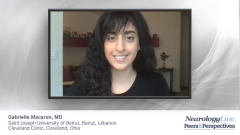
Assessing Response to Novel Oral Therapies in RRMS
The types of tests used to monitor response to novel oral therapies used in relapsing-remitting multiple sclerosis.
Episodes in this series

Jennifer Graves, MD, PhD, MAS: Once you’ve placed a patient on a specific medication, how do you monitor response to treatment and disease progression and whether you think that medication is successful?
Gabrielle Macaron, MD: The monitoring of treatment response is an incompletely resolved subject. There’s a lot of talk about NEDA [no evidence of disease activity]. It’s a potential combined outcome measure of treatment response. It usually corresponds with having absent clinical relapse, no MRI lesion activity, and no disability worsening as assessed by the EDSS [Expanded Disability Status Scale]. That’s an important point.
Several studies have suggested that NEDA is associated with better outcomes in MS [multiple sclerosis], but we now know that NEDA seems a bit unrealistic. Several paper show that in real-world cohorts, the percentage of patients achieving NEDA after several years is really low: below 10%. NEDA may be too sensitive, but it also paradoxically doesn’t seem to capture the whole process of MS. The items in NEDA are focused on disease activity and short-term accumulation of disability, which is associated with relapses. It doesn’t capture the whole disease process. Specifically, it doesn’t capture neurodegeneration.
There are other markers of treatment response that we’ve been talking about a lot in the MS world, such as brain volume loss, serum neurofilament lights, and cognitive impairment, but unfortunately those aren’t implemented routinely into care, so we can’t use them. We don’t have the perfect tool to measure treatment response in all patients at any time throughout the disease course because it’s a dynamic process.
In practice, we all evaluate clinically using MRI. MRI is a very important tool. I typically perform an MRI 4 to 6 months after starting a medication, and I use this as a re-baseline to allow for a treatment to work and not say that the treatment didn’t work when it wasn’t even in the system. After that, I recommend an MRI every 6 to 12 months, depending on the context and the patient. I also like to re-baseline the spinal cord as well to have a proper assessment of the whole central nervous system. With some DMTs [disease-modifying therapies], depending on the patient and the DMT, this monitoring can change, and it’s not the same for everybody.
Jennifer Graves, MD, PhD, MAS: Thank you. Dr Shah, how do you monitor people?
Suma Shah, MD: All of what Dr Macaron already mentioned, as well as the patients—a lot of expectation setting has to go into that to ensure that they’re not expecting these medications to help them feel better. Because the bottom line for many of these medications, as they’ve shown in clinical trials, is to reduce relapse rates and MRI activity, and that’s what we know they do.
There are various medications that we know can potentially help patients have improvement in some of their other reported scales, but that’s not something we expect on the whole. Speaking to the patient about how they’re doing, what they’re feeling, and whether it’s something new, in addition to having our clinical assessments and MRI evaluations, is really important. Then making sure that we have a really good definition of what a relapse is and what the tolerability is of a medication once they’ve started it. There’s not just disease progression, but how a patient is doing on a medication to help me determine, “Are we going to keep doing this, or is this something we need to potentially think about switching therapies from?”
Jennifer Graves, MD, PhD, MAS: Thank you for watching this NeurologyLive® Peer Exchange. If you enjoyed the content, please subscribe to our e-newsletters to receive upcoming Peer Exchanges and other great content right in your in-box.
Transcript edited for clarity.
Newsletter
Keep your finger on the pulse of neurology—subscribe to NeurologyLive for expert interviews, new data, and breakthrough treatment updates.




















